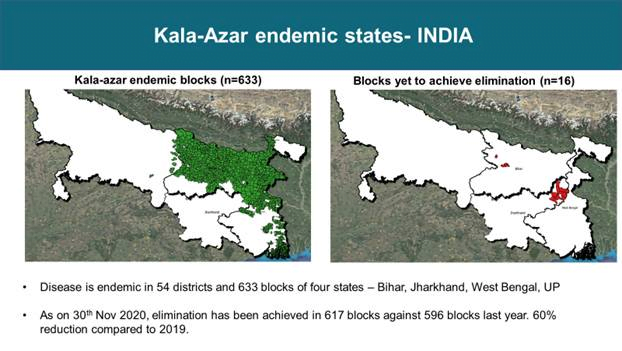UPSC Articles
Status of Kala Azar in Four States reviewed
Part of: GS Prelims and GS-II – Health
In news
- Union Minister of Health and Family Welfare recently reviewed the status of the disease Kala-Azar in the four states of Uttar Pradesh, Bihar, Jharkhand and West Bengal.
Key takeaways
- There are 54 districts in these four states that are currently affected by Kala-azar with sporadic cases in other states like Assam, HP, J&K, Kerala, Sikkim, and Uttarakhand.
- A risk based stratified approach needs to be formulated with clear activities and responsibilities that come with measurable monitoring indicators.
- Kala Azar disproportionately impacts the people at lower socio-economic strata of society whose houses are not sprayed often.
- In addition, they are unable to apply for pucca houses since they don’t own land.
The Central government has underlined the importance of the following activities to target the elimination of the disease:
- Development of a plan for the “unreached poorest” or underprivileged sections in endemic areas.
- Leveraging of Kala-azar elimination programme within POSHAN Abhiyaan for maximum benefit at community level.
- Exploration of the opportunity of providing improved housing under the flagship program of the Prime Minister Awas Yojana-Gramin (PMAY-G).
- Exploration of the opportunity of providing improved housing under State Schemes.
- Involvement of Rural Health Practitioners (RHPs)
- Co-ordination with the rural development department and engage with Panchayati Raj functionaries for awareness, community engagement, environment management and social empowerment.

Important value additions
Kala Azar
- A disease caused by infection with leishmania parasites.
- Visceral leishmaniasis is spread by sandfly bites.
- This type of leishmaniasis affects the internal organs, usually the spleen, liver and bone marrow.
- Some people have no symptoms.
- For others, symptoms may include fever, weight loss and swelling of the spleen or liver.
- Medication exists to kill the parasites.
- If left untreated, severe cases are typically fatal.
Do you know?
- Kala Azar is the 2nd largest parasitic killer in the world after Malaria.
- It results in a 95% fatality rate if the patients are not treated.
- Up to 20% of the patients who are correctly treated and cured, develop a skin condition called Post-Kala-Azar Dermal Leishmaniasis (PKDL) which surfaces within months to years after treatment.
- These patients can contain large amounts of parasites in their skin lesions, making them an important source of transmission.














